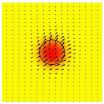(Press-News.org)
VIDEO:
This animation shows the development of the soliton over the course of about 2.7 nanoseconds. Current begins passing through the channel in the center, causing the magnetization to oscillate....
Click here for more information.
Researchers at the National Institute of Standards and Technology (NIST) have found theoretical evidence* of a new way to generate the high-frequency waves used in modern communication devices such as cell phones. Their analysis, if supported by experimental evidence, could contribute to a new generation of wireless technology that would be more secure and resistant to interference than conventional devices.
The team's findings point toward an oscillator that would harness the spin of electrons to generate microwaves—electromagnetic waves in the frequencies used by mobile devices. Electron spin is a fundamental property, in addition to basic electrical charge, that can be used in electronic circuits. The discovery adds another potential effect to the list of spin's capabilities.
The team's work—a novel variation on several types of previously proposed experimental oscillators—predicts that a special type of stationary wave called a "soliton" can be created in a layer of a multilayered magnetic sandwich. Solitons are shape-preserving waves
that have been seen in a variety of media. (They first were observed in a boat canal in 1834 and now are used in optical fiber communications.) Creating the soliton requires that one of the sandwich layers be magnetized perpendicular to the plane of the sandwiched layers; then an electric current is forced through a small channel in the sandwich. Once the soliton is established, the magnetic orientation oscillates at more than a billion times a second.
"That's the frequency of microwaves," says NIST physicist Thomas Silva. "You might use this effect to create an oscillator in cell phones that would use less energy than those in use today. And the military could use them in secure communications as well. In theory, you could change the frequency of these devices quite rapidly, making the signals very hard for enemies to intercept or jam."
Silva adds that the oscillator is predicted to be very stable—its frequency remaining constant even with variations in current—a distinct practical advantage, as it would reduce unwanted noise in the system. It also appears to create an output signal that would be both steady and strong.
The team's prediction also has value for fundamental research.
"All we've done at this point is the mathematics, but the equations predict these effects will occur in devices that we think we can realize," Silva says, pointing out that the research was inspired by materials that already exist. "We'd like to start looking for experimental evidence that these localized excitations occur, not least because solitons in other materials are hard to generate. If they occur in these devices as our predictions indicate, we might have found a relatively easy way to explore their properties."
INFORMATION:
* M.A. Hoefer, T.J. Silva and M.W. Keller. Theory for a dissipative droplet soliton excited by a spin torque nanocontact. Physical Review B, 82, 054432 (2010), Aug. 30. 2010. DOI: 10.1103/PhysRevB.82.054432
New wave: Spin soliton could be a hit in cell phone communication
2010-09-16
ELSE PRESS RELEASES FROM THIS DATE:
Rice study examines how bacteria acquire immunity
2010-09-16
HOUSTON -- (Sept. 15, 2010) -- In a new study this week, Rice University scientists bring the latest tools of computational biology to bear in examining how the processes of natural selection and evolution influence the way bacteria acquire immunity from disease.
The study is available online from Physical Review Letters. It builds upon one of the major discoveries made possible by molecular genetics in the past decade -- the revelation that bacteria and similar single-celled organisms have an acquired immune system.
"From a purely scientific perspective, this research ...
Research shows radiometric dating still reliable (again)
2010-09-16
Recent puzzling observations of tiny variations in nuclear decay rates have led some to question the science of using decay rates to determine the relative ages of rocks and organic materials. Scientists from the National Institute of Standards and Technology (NIST), working with researchers from Purdue University, the University of Tennessee, Oak Ridge National Laboratory and Wabash College, tested the hypothesis that solar radiation might affect the rate at which radioactive elements decay and found no detectable effect.
Atoms of radioactive isotopes are unstable and ...
Children's brain development is linked to physical fitness
2010-09-16
CHAMPAIGN, lll. – Researchers have found an association between physical fitness and the brain in 9- and 10-year-old children: Those who are more fit tend to have a bigger hippocampus and perform better on a test of memory than their less-fit peers.
The new study, which used magnetic resonance imaging to measure the relative size of specific structures in the brains of 49 child subjects, appears in the journal Brain Research.
"This is the first study I know of that has used MRI measures to look at differences in brain between kids who are fit and kids who aren't fit," ...
NIST data: Enabling the technical-basis for evacuation planning of high-rise buildings
2010-09-16
Researchers at the National Institute of Standards and Technology (NIST) are stepping up the pace for designing safer building evacuations by releasing large, numerical data sets that track the movement of people on stairs during high-rise building evacuation drills. The data sets will ensure that architects, engineers, emergency planners and others involved in building design have a strong technical basis for safer, more cost-effective building evacuations.
"While stairs have been used in buildings for ages, there is little scientific understanding of how people use ...
New GSI website experience puts product standards on the map
2010-09-16
Those looking for the latest product standards-related news, regulatory developments, events and workshops around the world now can turn to the new Global Standards Information (GSI) Web site (http://gsi.nist.gov). Launched on Sept. 1, 2010, the new site includes a variety of interactive tools and will serve as an essential "first stop" for users seeking up-to-date information on international product standards.
"Given the rapid adoption and complexity of new product standards both locally and globally, we realized we needed to create a new way for our customers to find ...
NIST finalizes initial set of smart grid cyber security guidelines
2010-09-16
The National Institute of Standards and Technology (NIST) has issued its first Guidelines for Smart Grid Cyber Security, which includes high-level security requirements, a framework for assessing risks, an evaluation of privacy issues at personal residences, and additional information for businesses and organizations to use as they craft strategies to protect the modernizing power grid from attacks, malicious code, cascading errors and other threats.
The product of two formal public reviews and the focus of numerous workshops and teleconferences over the past 17 months, ...
New supercomputer 'sees' well enough to drive a car someday
2010-09-16
New Haven, Conn.—Navigating our way down the street is something most of us take for granted; we seem to recognize cars, other people, trees and lampposts instantaneously and without much thought. In fact, visually interpreting our environment as quickly as we do is an astonishing feat requiring an enormous number of computations—which is just one reason that coming up with a computer-driven system that can mimic the human brain in visually recognizing objects has proven so difficult.
Now Eugenio Culurciello of Yale's School of Engineering & Applied Science has developed ...
Placebo successful in treating women with sexual dysfunction
2010-09-16
A new study published in the Journal of Sexual Medicine reveals that women with low sexual arousal experienced clinically significant symptom changes after taking a placebo.
Andrea Bradford, Ph.D., a psychologist at Baylor College of Medicine, along with co-author Cindy Meston, Ph.D. at the University of Texas at Austin, analyzed the behaviors and symptoms of 50 women who were randomly chosen to receive placebo in a large clinical trial of a drug treatment for low sexual arousal. Neither the women nor the study doctors knew whether they were taking the real drug or placebo.
Results ...
CEOs with top college degrees no better at improving long-term firm performance than other CEOs
2010-09-16
DURHAM, N.H. – Whether or not a company's CEO holds a college degree from a top school has no bearing on the firm's long-term performance. And when it comes to getting canned for poor performance, CEOs with degrees from the nation's most prestigious schools are no safer than the average CEO, according to new research from the University of New Hampshire.
Conducted by Brian Bolton, assistant professor of finance at the Whittemore School of Business and Economics at the University of New Hampshire, the new research is presented in the working paper "CEO Education, CEO Turnover, ...
Link to autism in boys found in missing DNA
2010-09-16
September 16, 2010 – (Toronto) – New research from the Centre for Addiction and Mental Health (CAMH) and The Hospital for Sick Children (SickKids), both in Toronto, Canada provides further clues as to why Autism Spectrum Disorder (ASD) affects four times more males than females. The scientists discovered that males who carry specific alterations of DNA on the sole X-chromosome they carry are at high risk of developing ASD. The research is published in the September 15 issue of Science Translational Medicine.
ASD is a neurological disorder that affects brain functioning, ...


